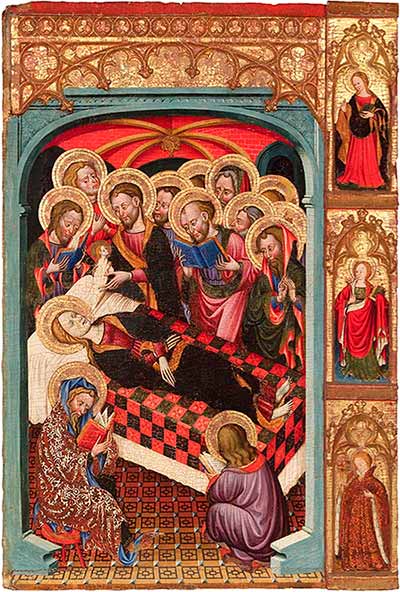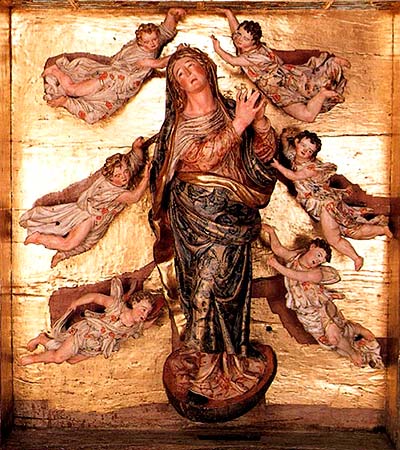16 August
lecture series
AROUND THE ASSUMPTION. FEAST AND ICONOGRAPHY
Iconography and feast around the Assumption
Ricardo Fernández Gracia
Chair of Navarrese Heritage and Art
The central days of August in Navarre, as in the rest of Spain, have traditionally had a religious reference point in the celebration of the Assumption of the Virgin, a festival with multiple expressions of a ludic, popular, devotional and musical nature. This devotion is held in 91 parishes in Navarre, only behind Saint Martin, who has 92, and well above other popular saints such as Saint Peter, who has 70, Saint Michael, with 56, and Saint James, with 10.
Its feast, so widespread for centuries, had theological support, but not in the sacred texts of the Bible, but in the apocrypha and the writings of some of the Holy Fathers. From the East, where it had been celebrated since the 4th century, it passed to the West, where it experienced a great boom from the 12th century onwards. It is only since 1950 that it has been one of the dogmas of the Catholic Church.
Its image references in Navarre have had several options over the centuries, with the topic of the Dormition standing out, visible in the exceptional doorways of the cloister of Pamplona Cathedral, the Gothic altarpieces of Tudela Cathedral, the panel of the main altarpiece of Tulebras and the image of the Virgin of the Bed in the latter monastery. From the 16th century onwards, the image of the Virgin had its own iconography, independent of her sleeping and the empty tomb next to the apostles, with great prominence in altarpieces, canvases and other representations in the sumptuary arts. Artists of great renown in regional and national art left outstanding examples in the cultural heritage throughout Navarre.
All of these representations were once a precious and coveted commodity, precisely because of their lack. The men and women of past centuries had plenty of time to examine the very few images they could admire, just the opposite of what happens today, when their issue is so large and our time so scarce that there is no possibility of contemplating them in detail.
The medieval references are to be found, as we have pointed out, in the cloister of Pamplona cathedral, in the doors of the Amparo and the Preciosa. Professor Fernández-Ladreda has related the former to Italian models of early 14th-century painting, although it must have been executed by a master from the south of France. The second, dating from the third quarter of the 14th century, has a programme inspired by the Assumptionist Apocrypha of John Archbishop of Thessalonica, which includes nine of the scenes on the cover, and influences of the Pseudo Joseph of Arimathea or the Pseudo John the Evangelist, as well as the Golden Legend, can also be detected.
We referred to the feast of the Assumption in the cathedral in an article on article in Diario de Navarra (20 August 2011), in which we collected from the medieval testimonies that speak of the vigilance of the first diocesan temple with a guard placed ex profeso and the obligation of all the vicars and presbyters of the city to attend on its feast day, to the great celebrations of the feast and the octave in the Modern Age.
The scene of the Dormition has very beautiful panels in the altarpieces of the Villaespesa chapel in Tudela cathedral (Bonanat Zaortiga, 1412) and in the main altarpiece there, a work by Pedro Díaz de Oviedo commissioned in the late 15th century. In the monastery of Tulebras, the main panel of its main altarpiece, the work of Jerónimo Cosida (1565-1570), represents the same passage and the image of the Virgin of the Bed, from the early 17th century, is one of the very few examples we know of in Navarre of this subject of images. Specifically, we only know of three other images: in the closed monastery of the Poor Clares of Fitero (from Calatayud), in El Carmen in Tudela, and in the Carmelites of Araceli in Corella. This last image, small in size, arrived at the Corella cloister between 1930 and 1947 as a donation from the mother of the Jesuit Martín Sánchez Arellano (Corella, 1861-Zaragoza, 1918), director , spiritual director of the foundress of the Angelicas, Saint Genoveva Torres Morales, in whose high school he is considered to be the co-founder.

Villaespesa Chapel (1412).
Allusions to the empty tomb survive in the figurative arts of the Modern Age. In the central panel of the altarpiece in the monastery of La Oliva, now in San Pedro de Tafalla, Rolan Mois recreated Titian's model of the upright Virgin, depicting her "with the proportion of a large, highly polished human body, and in rich, graceful colours". His model is repeated in the painting in the chapel of the Cervantes Enríquez de Lacarra family in the church of La Victoria in Cascantina, while in other cases also linked to Aragonese painting, the Virgin appears seated, following Zúcaro's model in El Escorial, as in the altarpiece of the Assumption in the monastery of Fitero. In sculptural examples we also find the groups of apostles around the tomb in the lower part and the Assumptionist group in the upper part, as in the altarpieces of Valtierra (1577-1590), Cascante (1587-1601) and Villafranca (1786-1789).
However, the great Assumptionist flowering would come at the beginning of the 16th century with images with angelic cut of greater or lesser development and in different aesthetics, from the late Gothic of Marañón to those of expressive models, such as the paintings of Cizur Mayor (1538) or the sculptures of Genevilla (1549-1563), and the countless Romanists of so many altarpieces in the Comunidad Foral, the most important of which are the altarpieces of Santa María de Tafalla (1583), Cáseda (1576-1581) and the cathedral of Pamplona (1597).

Genevilla (1549-1563).
Among the Baroque examples from the 17th century, mention should be made of those in the parishes of Los Arcos and Viana, the latter being the work of the Calceta sculptor Bernardo de Elcaraeta (1663-1674). In the altarpieces of plenary session of the Executive Council Baroque altarpieces, Assumptionist groups play a major role, as in the attics of the altarpieces of Miranda de Arga (1696) and San Miguel de Corella (1718-1722). Among the models belonging to the Rococo period are those of the altarpieces of Goizueta (1760) and Lerín (1759).
Vicente Berdusán left excellent canvases with the topic in the attic of the main altarpiece of the Rosary in Corella and in the parish church of San Pedro de Viana (1687), today in the sacristy of Santa María in the same town, copying a Rubensian composition that is widespread in numerous prints. In San Francisco de Viana, Francisco del Palno left a very fine example in one of his mock altarpieces in the second decade of the 18th century. The painting that presides over the front wall of the sacristy of the canons' vestry in Pamplona cathedral, by Pedro Antonio de Rada, dates from 1762.
Examples of academic sculpture include group de Echalar and the one in the portico of Pamplona Cathedral. The former was signed in Seville in 1781 by the sculptor Blas Molner, a sculptor trained at the Valencian Academy and who moved to Seville in 1791, where he became director of the Sculpture School of the Academy of Fine Arts. The Pamplona cathedral is the work of Julián San Martín, who was awarded the contract, following proposals from other sculptors such as Manuel Martín Rodríguez - the nephew of Don Ventura - Juan Adán, lieutenant director of the San Fernando Academy, Alfonso Bergaz and José de Folch.
